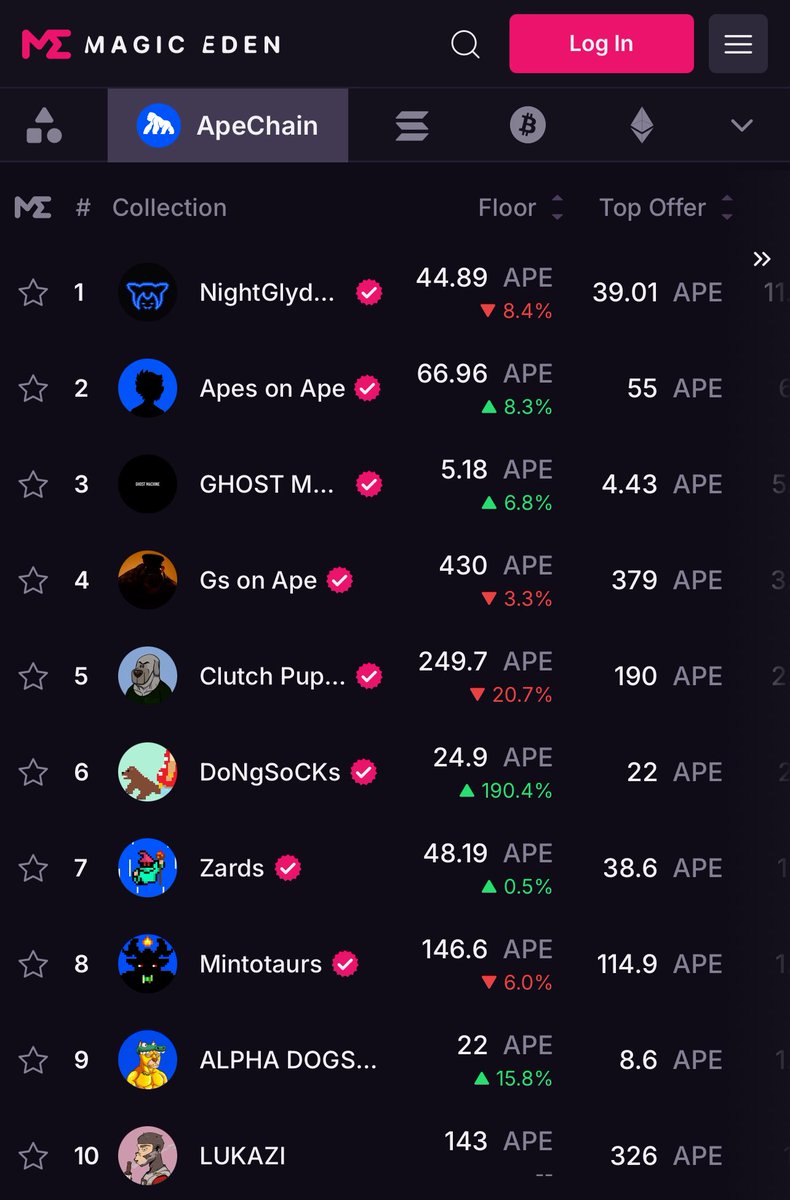
APE
ApeCoin price
$0.55900
-$0.01400
(-2.45%)
Price change for the last 24 hours

How are you feeling about APE today?
Share your sentiments here by giving a thumbs up if you’re feeling bullish about the coin or a thumbs down if you’re feeling bearish.
Vote to view results
ApeCoin market info
Market cap
Market cap is calculated by multiplying the circulating supply of a coin with its latest price.
Market cap = Circulating supply × Last price
Market cap = Circulating supply × Last price
Circulating supply
Total amount of a coin that is publicly available on the market.
Market cap ranking
A coin's ranking in terms of market cap value.
All-time high
Highest price a coin has reached in its trading history.
All-time low
Lowest price a coin has reached in its trading history.
Market cap
$447.22M
Circulating supply
799,455,492 APE
79.94% of
1,000,000,000 APE
Market cap ranking
52
Audits

Last audit: Mar 24, 2022, (UTC+8)
24h high
$0.58700
24h low
$0.52800
All-time high
$28.0000
-98.01% (-$27.4410)
Last updated: Mar 17, 2022, (UTC+8)
All-time low
$0.34870
+60.30% (+$0.21030)
Last updated: Apr 7, 2025, (UTC+8)
ApeCoin Feed
The following content is sourced from .
APE calculator


ApeCoin price performance in USD
The current price of ApeCoin is $0.55900. Over the last 24 hours, ApeCoin has decreased by -2.44%. It currently has a circulating supply of 799,455,492 APE and a maximum supply of 1,000,000,000 APE, giving it a fully diluted market cap of $447.22M. At present, ApeCoin holds the 52 position in market cap rankings. The ApeCoin/USD price is updated in real-time.
Today
-$0.01400
-2.45%
7 days
-$0.10490
-15.81%
30 days
-$0.08280
-12.91%
3 months
+$0.0019000
+0.34%
Popular ApeCoin conversions
Last updated: 06/23/2025, 07:35
| 1 APE to USD | $0.55920 |
| 1 APE to PHP | ₱31.9706 |
| 1 APE to EUR | €0.48789 |
| 1 APE to IDR | Rp 9,180.76 |
| 1 APE to GBP | £0.41732 |
| 1 APE to CAD | $0.76957 |
| 1 APE to AED | AED 2.0537 |
| 1 APE to VND | ₫14,611.97 |
About ApeCoin (APE)
The rating provided is an aggregated rating collected by OKX from the sources provided and is for informational purpose only. OKX does not guarantee the quality or accuracy of the ratings. It is not intended to provide (i) investment advice or recommendation; (ii) an offer or solicitation to buy, sell or hold digital assets; or (iii) financial, accounting, legal or tax advice. Digital assets, including stablecoins and NFTs, involve a high degree of risk, can fluctuate greatly, and can even become worthless. The price and performance of the digital assets are not guaranteed and may change without notice. Your digital assets are not covered by insurance against potential losses. Historical returns are not indicative of future returns. OKX does not guarantee any return, repayment of principal or interest. OKX does not provide investment or asset recommendations. You should carefully consider whether trading or holding digital assets is suitable for you in light of your financial condition. Please consult your legal/ tax/ investment professional for questions about your specific circumstances.
Show more
- Official website
- Block explorer
About third-party websites
About third-party websites
By using the third-party website ("TPW"), you accept that any use of the TPW will be subject to and governed by the terms of the TPW. Unless expressly stated in writing, OKX and its affiliates ("OKX") are not in any way associated with the owner or operator of the TPW. You agree that OKX is not responsible or liable for any loss, damage and any other consequences arising from your use of the TPW. Please be aware that using a TPW may result in a loss or diminution of your assets.
Latest news about ApeCoin (APE)

Yuga Labs Proposes Scrapping ApeCoin DAO, Launching ApeCo
The proposal from CEO Greg Solano would dissolve ApeCoin’s DAO, transfer its multibillion-token treasury to a new Yuga Labs-controlled vehicle and double down on ApeChain, Bored Apes and Otherside.
Jun 6, 2025|CoinDesk
ApeCoin FAQ
What is ApeCoin?
ApeCoin, a novel cryptocurrency introduced on the Ethereum network, functions as the native token within the APE ecosystem. This ecosystem incorporates the ApeCoin DAO and all APE services and products. The APE Foundation oversees the management of the token and the decision-making process within the ApeCoin DAO, where ApeCoin holders exclusively participate as voters, facilitated by the Foundation.
How many ApeCoin are there?
Apecoin has a capped total supply of 1 billion tokens. ApeCoin will not be burned, so its supply will never go down. The tokens are distributed among various groups within the ecosystem with varying lock-in periods to prevent their prices from falling drastically.
What is the APE price prediction?
While it’s challenging to predict the exact future price of APE, you can combine various methods like technical analysis, market trends, and historical data to make informed decisions.
How much is 1 ApeCoin worth today?
Currently, one ApeCoin is worth $0.55900. For answers and insight into ApeCoin's price action, you're in the right place. Explore the latest ApeCoin charts and trade responsibly with OKX.
What is cryptocurrency?
Cryptocurrencies, such as ApeCoin, are digital assets that operate on a public ledger called blockchains. Learn more about coins and tokens offered on OKX and their different attributes, which includes live prices and real-time charts.
When was cryptocurrency invented?
Thanks to the 2008 financial crisis, interest in decentralized finance boomed. Bitcoin offered a novel solution by being a secure digital asset on a decentralized network. Since then, many other tokens such as ApeCoin have been created as well.
Will the price of ApeCoin go up today?
Check out our ApeCoin price prediction page to forecast future prices and determine your price targets.
Monitor crypto prices on an exchange
Watch this video to learn about what happens when you move your money to a crypto exchange.
Disclaimer
The social content on this page ("Content"), including but not limited to tweets and statistics provided by LunarCrush, is sourced from third parties and provided "as is" for informational purposes only. OKX does not guarantee the quality or accuracy of the Content, and the Content does not represent the views of OKX. It is not intended to provide (i) investment advice or recommendation; (ii) an offer or solicitation to buy, sell or hold digital assets; or (iii) financial, accounting, legal or tax advice. Digital assets, including stablecoins and NFTs, involve a high degree of risk, can fluctuate greatly. The price and performance of the digital assets are not guaranteed and may change without notice.
OKX does not provide investment or asset recommendations. You should carefully consider whether trading or holding digital assets is suitable for you in light of your financial condition. Please consult your legal/tax/investment professional for questions about your specific circumstances. For further details, please refer to our Terms of Use and Risk Warning. By using the third-party website ("TPW"), you accept that any use of the TPW will be subject to and governed by the terms of the TPW. Unless expressly stated in writing, OKX and its affiliates (“OKX”) are not in any way associated with the owner or operator of the TPW. You agree that OKX is not responsible or liable for any loss, damage and any other consequences arising from your use of the TPW. Please be aware that using a TPW may result in a loss or diminution of your assets. Product may not be available in all jurisdictions.
OKX does not provide investment or asset recommendations. You should carefully consider whether trading or holding digital assets is suitable for you in light of your financial condition. Please consult your legal/tax/investment professional for questions about your specific circumstances. For further details, please refer to our Terms of Use and Risk Warning. By using the third-party website ("TPW"), you accept that any use of the TPW will be subject to and governed by the terms of the TPW. Unless expressly stated in writing, OKX and its affiliates (“OKX”) are not in any way associated with the owner or operator of the TPW. You agree that OKX is not responsible or liable for any loss, damage and any other consequences arising from your use of the TPW. Please be aware that using a TPW may result in a loss or diminution of your assets. Product may not be available in all jurisdictions.
APE calculator









































Socials